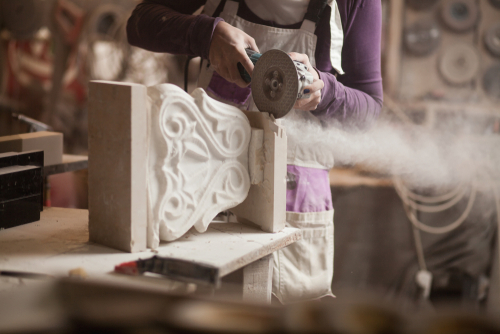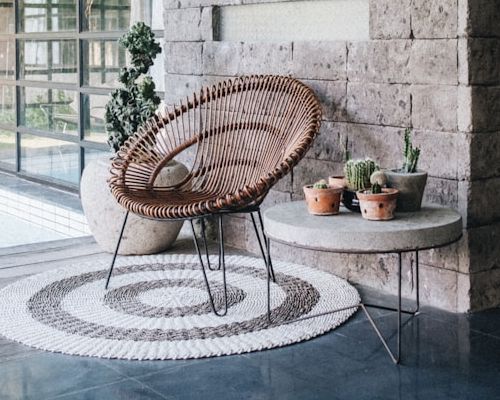Stonework is one of the most architecturally appealing elements to any building. Whether it is a rough stone finish on a feature of a house, such as a chimney, entrance or specific walls, or a more subtle smooth surround to a pool area, patio or walkway, stonework has its own place in any building. Stone is one of the materials most widely used in the building and construction industries. It is certainly one of the most effective and attractive ways of adding an element of glamour and individuality to any building. The versatility of stone makes it adaptable for both interior and exterior use.

There are many different types of stone available, from natural to man-made materials. Natural stone or rock is, in itself, both beautiful and unique, and offers a wide choice to suit any taste. Sandstone, granite, obsidian, marble, onyx, quartzite, diorite, slate, travertine, limestone, basalt and pumice, amongst many others, are all formed naturally and have different strengths and appearances.
Stonemasons use natural rock as well as manufactured rocks or artificial stone, so it is wise to know the strengths and attributes of each type of rock prior to deciding which type to use. Artificial stone is made from cement mixtures, often mixed with marble or glass chips or other similar elements which create decorative effects.
Whilst stonemasons will advise and guide you on which rock is most suitable for the application it is intended for, general knowledge of rock formation, appearance, strengths and weaknesses is always useful.
Let’s look at the three main types of natural rock :
There are three main types of natural rock : igneous rock, sedimentary rock, and metamorphic rock, which can be briefly described as follows :
Igneous rocks are solidified from magma, a molten mixture of rock-forming minerals, gases and steam. The constituent minerals are crystallised from molten material, indicating that igneous rocks are formed at high temperatures from deep within the earth at depths ranging from 50 to 200 kilometres. Igneous rocks are subdivided into two categories – intrusive (in which magma cools within the surface crust) and extrusive (formed when hot magma is either violently exploded out and falls back onto the surface as pyroclastic rocks, or flows onto the surface as lava). Pyroclastic rocks are clastic rocks comprising rock fragments produced by volcanos and erupted as individual rock fragments. Clastic rocks are defined as “ … rocks (which) are composed of fragments, or clasts, or pre-existing minerals and rock. A clast is a fragment of geological detritus, chunks and smaller grains of rock broken off other rocks by physical weathering“. (Wikipedia)
Sedimentary rocks, which are deposited, compacted and cemented together on the earth’s surface through the actions of running water, wind, ice or living organisms. These rocks are mostly found on the bottoms of lakes, rivers and oceans. Such rocks have a layered makeup in which bands of different colours, particle size, cementation and internal arrangement can be clearly seen.
Metamorphic rocks are formed when pre-existing rocks are changed, often by processes deep within the earth’s surface, under the influences of high temperature, pressure and active chemical solutions. Such changes are either chemical (compositional) or physical (textural) and result in the formation of new minerals, textures and crystal structures. Metamorphism often produces apparent layering or banding due to the segregation of minerals into separate bands or layers. Repetitive layering in metamorphic rocks is called foliation, and these layers can be anything from paper-thin to over a metre in thickness. Flat or elongate minerals within a rock become aligned through the squeeze effect of pressure on the rocks.
Some of the natural rocks most commonly found and used are :
Marble. A metamorphic rock, beginning its life as granular limestone or dolomite which has been recrystallised due to heat, pressure and various aqueous solutions. Dependent upon the type of minerals present during recrystallisation, marble may be tinted in a wide variety of colours, including the more common blue, grey, pink and red. This rock may also be found in green, purple and yellow colours. Clay, mica, quartz and iron oxides – the most common minerals found in marble – cause reddish, grey and white tints or veining. Red, pink and brown hues are caused by the presence of Hematite and iron oxides, whilst limonite results in a yellow colour. Rich, deep greens are due to the presence of serpentine. Nonetheless, although highly veined marble is much prized, purity itself depends on lack of colour variation within any specific sample, so the purest marble is almost completely white or very light in colour. The veining is caused by mineral deposits that are either within the original limestone or are present as the limestone is transforming into marble. The minerals tend to settle in layers, which we call “veining”. Depending on the volume of minerals present in the stone, the veining can either be very minimal — thin, delicate lines — or dramatic — large swaths of colours that can seem almost like smoke within the marble. Marble has a crystalline sparkle and is translucent, allowing light to penetrate and shine, and has a low water absorption factor, making it popular for kitchens and bathrooms.
Sandstone. This is made from sand grains which have become cemented together and present a rough, granular texture rather like sandpaper. Sandstone is a sedimentary rock formed under the oceans, in lakes and rivers, and is composed mostly of quartz sand, but may also have large amounts of feldspar and even silt and clay. Feldspar and quartz are the two organic minerals which are most resistant to climatic and weathering processes. Sandstone which comprises more than 90% quartz is called quartzose sandstone. Sandstone is typically a light tan in colour as it is composed of light-coloured minerals. Its durability depends on the materials cementing it together, for instance, sandstone cemented with silica is very durable and hard, whilst calcite-cemented sandstone is more easily eroded and prone to acidic dissolution. The softest sandstone results from cementation with clay and gypsum which are both soft minerals, and the resulting material can sometimes be rubbed off by hand. Due to it being porous, sandstone is prone to liquid staining, mould and bacterial growth. Sandstone is used in masonry works, dams, bridge piers and river walls.
Limestone. This is an organic, sedimentary rock which is formed through the breakdown of rocks, shells, skeletal fragments of marine organisms such as coral and molluscs which have been compressed over the years to form solid rock. Limestone is formed in layers called bedding planes. It is extremely durable with a rustic appeal, but is not recommended for heavy vehicular traffic areas. Limestone may present as yellow, white or grey. It is a strong, dense stone with few pore spaces, making it one of the most durable and weather-resistant materials. Natural corrosion will occur over time, but this is mostly superficial and will not have an appreciable impact on the structural integrity of any building. Limestone is mostly crushed and used as a construction material for road bases and as an aggregate in concrete. Its use in building is in facing stone, stair treads, window sills, floor tiles, etc. In construction, it is used for flooring, roofing, pavements and as a base material for cement. Limestone facing stones should not be used in coastal areas where salt winds can damage them.
Slate, a fine-grained, foliated, homogeneous metamorphic rock formed primarily from volcanic ash and clay which have been exposed to intense heat and pressure. This rock is usually grey in colour. This stone is valued for its waterproof and stain resistant nature and durability, and is therefore popular for roofing, flooring slabs, flagging and pavements. Slate is one of the strongest natural stone flooring materials, being resistant to cracks, scratches, breaks and chips.
Quartzite. This is a hard, nonfoliated metamorphic rock formed by the effect of heat, pressure and chemical activity on quartz-rich sandstone and produces a network of interlocking quartz grains of incredible strength. This rock usually presents as white or grey but may more rarely be found in other pale colours. It is resistant to UV rays and requires less maintenance than materials such as marble. This stone is becoming more popular for countertops as it is harder and more stain resistant than granite, but with a marble-like appearance. On the negative side, Quartzite is not heat-resistant and can easily be damaged by hard knocks and knives if cutting directly on the surface. Quartzite is recognized as a decorative stone and may be used to cover walls, in roofing tiles, flooring and stairs. It may also be used in building blocks, slabs and as an aggregate in concrete.
Travertine. This is a sedimentary rock which is a type of limestone (although it is often classified as a form of marble), which has been subjected to intense hear and pressure below the earth’s surface. Cross-cutting this rock will result in marbled patterns, whilst ‘vein-cutting’ will result in more of a wood-grain appearance. Due to its large number of pore spaces, it easily absorbs water and moisture, and can therefore be used both indoors and outdoors. Tumbled travertine (with a textured and porous surface) is perfect for outdoor use, especially around swimming pools and spa areas due to its high moisture absorption and heat resistance. Honed (smooth and matte) and polished (smooth and shiny) travertine should be used only on internal applications. Travertine tiles are commonly used for bathroom and kitchen flooring, to decorate walls and countertops. It contains a variety of soft colours and hues from white to beige, brown and grey. Be aware that it is prone to staining because of its porous nature, so red wine and tomato sauce, for example, need to be cleaned immediately. Travertine is heat-resistant and non-flammable so is an ideal surround for a fireplace. It is highly impact-resistant and durable. The Roman Coliseum was constructed from travertine, which proves its resistance to wear.
Granite. This rock is formed from the slow crystallisation of magma under the earth’s crust. This is an igneous rock comprising quartz, alkali feldspar and plagioclase feldspar, together with various minerals which give it texture and colour. Granite is a very strong rock which is ideal for heavy traffic areas such as outdoor driveways and indoor countertops. Granite is known as one of the oldest, hardest and strongest stones available, with the only material stronger than granite being a diamond, although quartzite is a close contender and even comes in as being harder than granite on the Mohs scale of hardness. Granite will not crumble or break over time, unlike many other natural rocks, and has hundreds of colours and patterns to choose from.
Try to choose natural rock wherever possible
Whatever your needs are, there is a natural rock which is suitable for the purpose. You can, of course, choose to opt for manufactured materials, but there is nothing like bringing the beauty of nature into your immediate environment wherever possible, and ‘going green’ is definitely the right way of achieving this. Natural rock is uniquely individual in its own right, as no two pieces (much like wood) are the same. To get the most beauty and individuality out of your budget, speak to your local stonemason specialist and then wait for the magic to happen!
